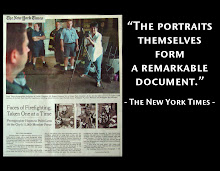When I started photographing members of FDNY, I wanted to keep my work quiet and private. I was not interested in publicity or any other kind of attention for this work. I certainly didn't want to wake up any sleeping giants. More importantly, the trust and confidence the guys placed in me as a friend before 9/11 was important to honor. It was common to hear something about being there for them before the attacks. It pleased them that I hadn't "jumped on the bandwagon" as they put it. In the years that followed, some would say they felt forgotten by the public but appreciated that I was still there. It meant a lot to them and to me.
So I wanted this work to be between me and the firefighters. It was no one else's business. I didn't want anyone to think I was doing this for attention. I certainly didn't do it for money since I volunteered.
But on March 10, 2002, I feared my privacy had come to an end.
I was making a return visit to a station in my neighborhood, Engine 22 & Ladder 13 on East 85th St. on the Upper East Side of Manhattan.
It was a cold Sunday when a woman and her child approached the firefighter I was photographing. She explained that during the week, her daughter Sophie's class delivered a handmade poster honoring firefighters. But, she added, her daughter was ill that day, stayed home sick, and missed the class trip to the fire house. Sophie looked sad and disappointed.
"Would it be okay if she comes in to see the poster?" she asked. Her daughter, clinging to her mother, seemed a little shy and anxious. I know how anxious I was the first time I approached a firefighter and asked to enter his home.
But Doug Mitchell, like most firefighters in New York City, was gracious and hospitable. "Of course," he said, taking the child's hand and leading her to the back of the station where the poster was prominently displayed above the vending machines. Connie and I followed to see the poster, too.
Sophie looked at it proudly, but it didn't seem as fun as it would have if she'd been with her classmates. I had an idea. "Would you like me to take your picture with the poster?" I asked. I thought it might be fun to take the photo to school and share with her classmates.
I studied the scene and thought if Doug lifted her on his shoulder I'd be able to get the poster and a firefighter in the shot.

Doug picked her up and placed her on his right shoulder. She was thrilled! She settled into the shot, letting go of her shyness and anxiety. She felt safe on Doug's shoulder. Who wouldn't?
Afterwards, her mother approached me and asked, "How can I get a copy of this photo?"
I asked for her address and promised I would mail a copy to her.
"Just mail it to my office," she said, handing me her business card. I looked at the embossed letters on the card and felt an earthquake under my feet worrying that I might be in trouble. Constance Hays was a business reporter at The New York Times. Among her many credits, she covered the Martha Stewart trial for the Times and was the author of a gripping book, "The Real Thing: Truth and Power at the Coca-Cola Company."
I could have avoided her and not mailed it. But once again, I kept my promise to deliver the photo. So I mailed it to Constance. I wanted the thank you she emailed to be the end of it. I hoped nothing more would come of the encounter. But four months later a surprise call came in.
"This is Lydia Polgreen from The New York Times," the voice on the other end of the phone announced. "I hear you're working on a large project," she said, laughing on the word "large." She went on to explain that she wanted to follow me for a day through fire houses with a photographer for one of the articles planned to commemorate the first anniversary of 9/11.
The story idea had come from Constance Hays.
I called several friends and asked, "What should I do?" They helped me to see that the story wasn't about me. It was just a different angle on a story about brave firefighters who survived 9/11. A story about honoring them through photos was a way for the Times to focus their story through my camera. I wasn't the story. Firefighters were.
That became my reason for allowing other interviews that followed. Another way to focus attention on firefighters.
The impact of the article went beyond my expectations. It appeared on September 3. Before the end of that day I heard from The Today Show, CBS, Ladies' Home Journal, NY1, Fuji TV in Tokyo and more.
I took the New York Times to Brooklyn so I intentionally asked CBS to follow me to Queens, LHJ to Staten Island, Fuji TV to Manhattan, and NY1 to the Bronx. Chief Rocky Jones (read her story below) made all the arrangements for approvals from the Department. I asked her to accompany me to 30 Rockefeller and appear on The Today Show with me.
When the article appeared, I called Constance and thanked her. It was a brief conversation. I know reporters are always on deadline. I heard from her a couple of years later when she called to request another copy of the photo.
I left New York in November, 2005 to begin adding other firefighters to the FDNY portraits already recorded. But I still read all the New York newspapers online.
So imagine how stunned I was to read in December, 2005, that Constance Hays died from cancer at the age of 44. My heart sank recalling that day in March. We may have only spent 30 minutes together, but we made an important connection that would change lives. By shining the bright spotlight of The New York Times on the project, it attracted the attention of firefighters and their families across the country.
Like so many others who have made small and enormous contributions to advance The Archive, Connie Hays made one the biggest.
As firefighters say, we will "Never Forget." Thank you Connie. Our condolences to Sophie and the rest of your family for their loss.


No comments:
Post a Comment